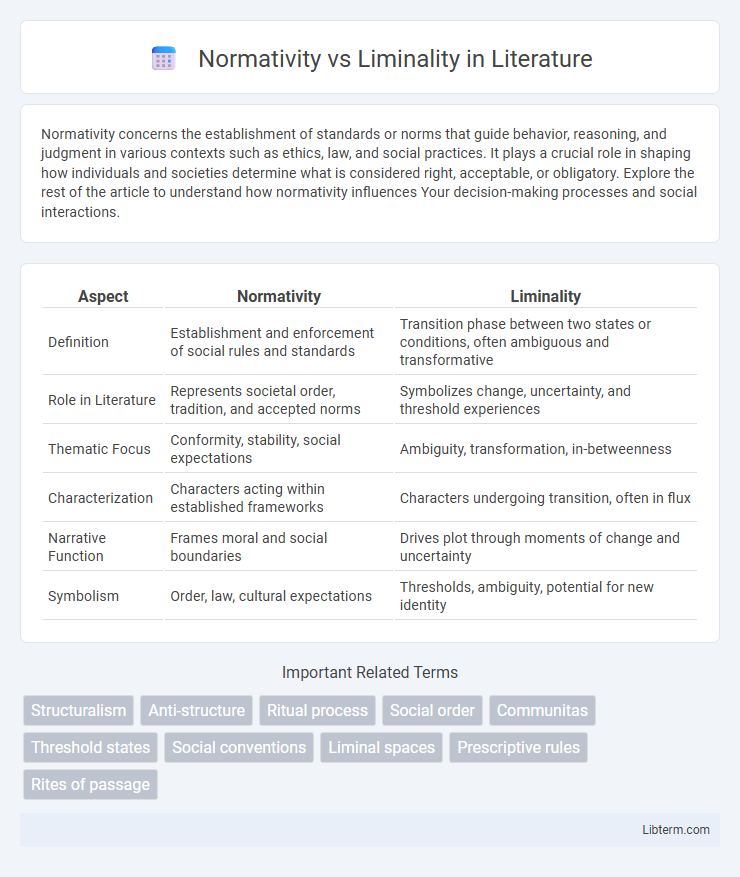Normativity concerns the establishment of standards or norms that guide behavior, reasoning, and judgment in various contexts such as ethics, law, and social practices. It plays a crucial role in shaping how individuals and societies determine what is considered right, acceptable, or obligatory. Explore the rest of the article to understand how normativity influences Your decision-making processes and social interactions.
Table of Comparison
| Aspect | Normativity | Liminality |
|---|---|---|
| Definition | Establishment and enforcement of social rules and standards | Transition phase between two states or conditions, often ambiguous and transformative |
| Role in Literature | Represents societal order, tradition, and accepted norms | Symbolizes change, uncertainty, and threshold experiences |
| Thematic Focus | Conformity, stability, social expectations | Ambiguity, transformation, in-betweenness |
| Characterization | Characters acting within established frameworks | Characters undergoing transition, often in flux |
| Narrative Function | Frames moral and social boundaries | Drives plot through moments of change and uncertainty |
| Symbolism | Order, law, cultural expectations | Thresholds, ambiguity, potential for new identity |
Understanding Normativity: Defining the Social Standard
Normativity refers to the established social standards and rules that guide acceptable behaviors, beliefs, and values within a community or society. It functions as a framework that shapes individual and collective actions by setting expectations for conformity and social order. Understanding normativity involves analyzing how these standards are constructed, maintained, and challenged within cultural and institutional contexts.
Liminality Explained: Thresholds and Transitional Spaces
Liminality refers to the transitional phase in rites of passage where individuals exist between their previous identity and a new status, often characterized by ambiguity and openness to change. This concept emphasizes thresholds and transitional spaces that disrupt normative structures, allowing for transformation and redefinition of social roles. In contrast to normativity, which enforces established rules and regularity, liminality highlights fluidity, potential, and the suspension of conventional boundaries.
The Interplay Between Normativity and Liminality
The interplay between normativity and liminality highlights how established social norms are both challenged and redefined in transitional spaces, where individuals or groups exist on the threshold of conventional boundaries. Liminality creates a dynamic environment for negotiating identity, power, and meaning, often resulting in the transformation or reinforcement of normative structures. This tension between stability and change underscores the fluid nature of social order and cultural practices.
Cultural Examples of Normative Structures
Normative structures in culture are exemplified by institutions such as legal systems, religious organizations, and educational frameworks that establish and enforce societal rules and values. For instance, the caste system in India delineates social hierarchy and prescribes behavior, reflecting deeply ingrained normative expectations. In Western societies, marriage laws and formal schooling exemplify normative structures that regulate personal relationships and knowledge transmission, reinforcing social order.
Liminal Spaces in Rituals and Society
Liminal spaces in rituals represent transitional phases where participants exist betwixt and between established norms, facilitating transformation and social rebirth. These ambiguous zones challenge normative structures by suspending usual social roles, thus creating opportunities for new identities and communal bonds to emerge. Emphasizing liminality highlights its critical function in maintaining societal cohesion through ritualized periods of flux and ambiguity.
Challenges to Normativity: The Role of Liminal Phases
Challenges to normativity emerge prominently during liminal phases, where conventional social structures and norms become ambiguous or suspended, prompting individuals and groups to navigate uncertainty and transformation. These transitional states disrupt established behavioral expectations, fostering spaces for creativity, resistance, and new normative frameworks to develop. Understanding the dynamics of liminality reveals critical insights into how societal change and identity reformation challenge and reshape dominant normative paradigms.
Identity Formation in Liminal Contexts
Normativity in identity formation emphasizes adherence to established social roles and cultural expectations, providing individuals with a structured sense of self. Liminality involves transitional or in-between states where conventional norms are suspended, allowing for fluid and dynamic identity exploration. In liminal contexts, identity formation becomes a process of negotiation and transformation, enabling individuals to reconstruct their sense of self beyond normative boundaries.
Societal Impacts of Sustained Liminality
Sustained liminality disrupts societal norms by creating prolonged states of ambiguity and uncertainty, which challenge traditional frameworks of order and social roles. This persistent transitional phase can lead to increased social fragmentation and weakened communal bonds as individuals and groups struggle to find stability within fluctuating cultural or institutional boundaries. The societal impact includes shifts in identity formation, governance challenges, and a potential rise in anxiety and resistance towards established norms.
Normativity and Liminality in Contemporary Discourse
Normativity in contemporary discourse establishes accepted social standards and behavioral expectations, shaping collective identity and cultural coherence. Liminality challenges these fixed norms by highlighting transitional states and ambiguity, fostering spaces for creativity and transformation. The interplay between normativity and liminality reveals ongoing tensions in societal adaptation and the renegotiation of boundaries.
Moving Beyond Boundaries: Embracing Liminal Complexity
Embracing liminal complexity involves moving beyond rigid normativity by acknowledging the fluid and transitional spaces where identities and meanings continuously evolve. This approach challenges traditional binary frameworks, fostering a dynamic understanding of social, cultural, and psychological boundaries. By valuing ambiguity and transformation, liminality encourages inclusive practices that reflect the complexities of lived experiences in contemporary society.
Normativity Infographic

 libterm.com
libterm.com